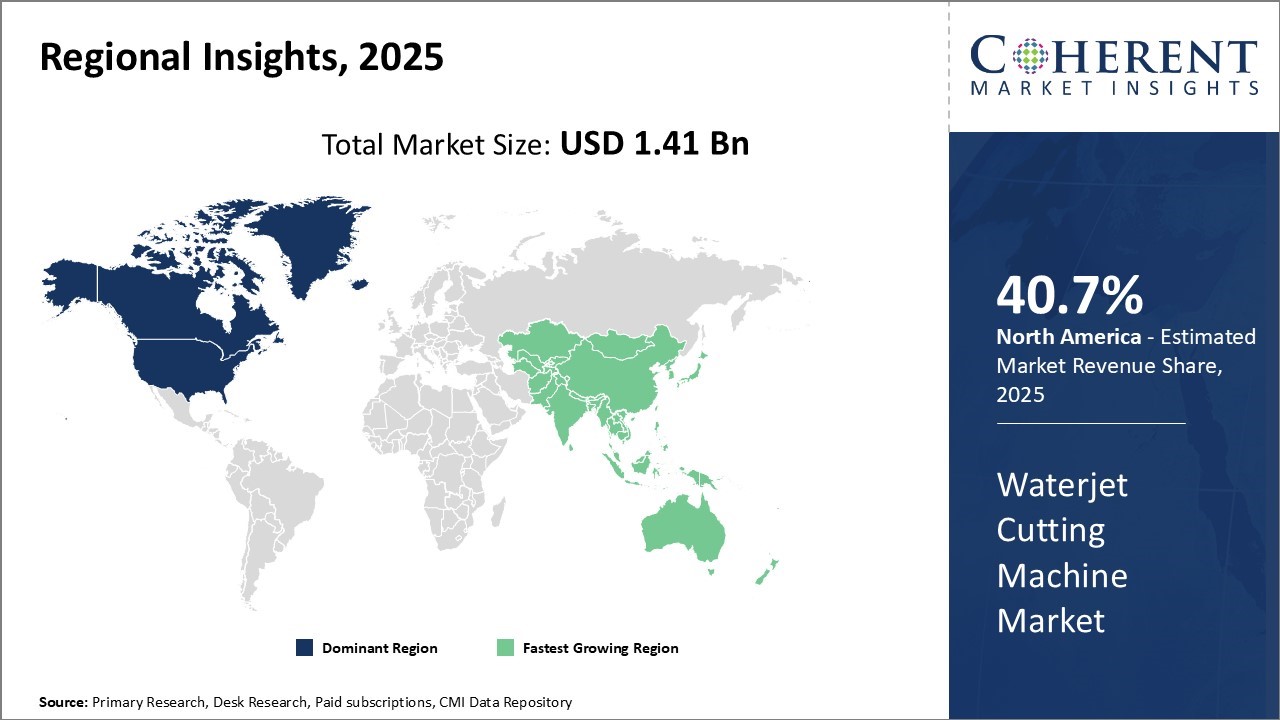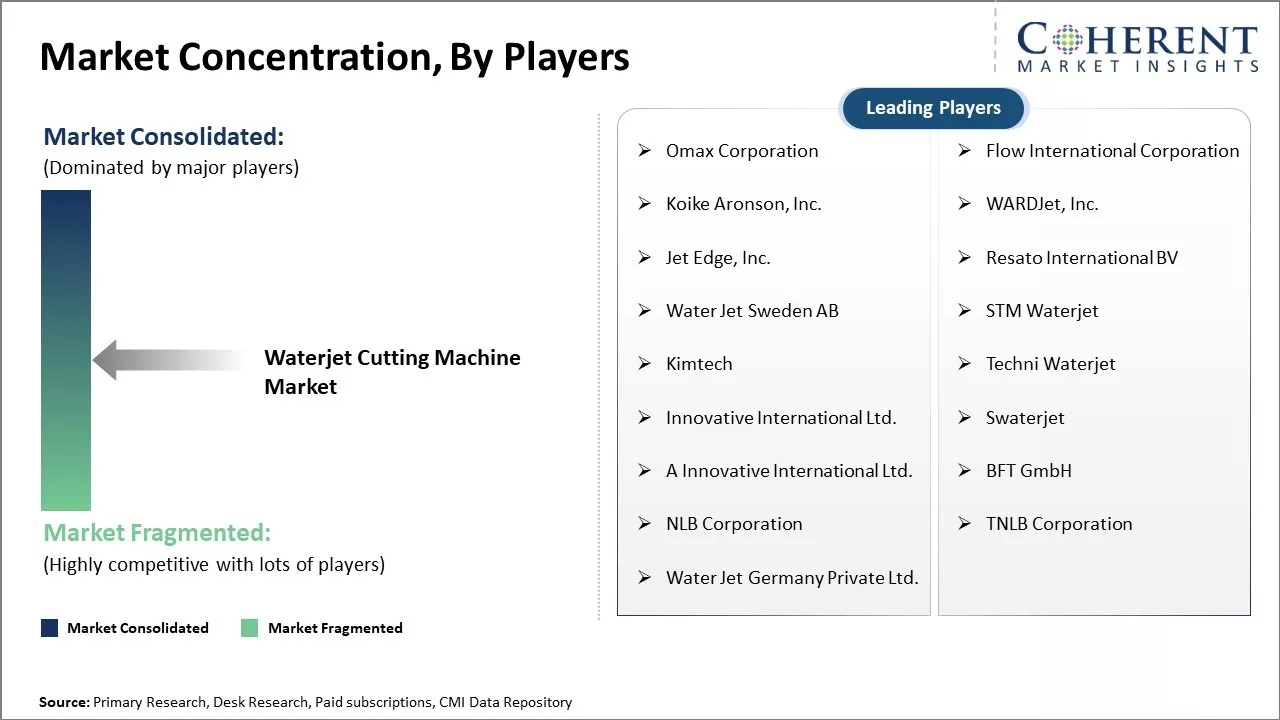The waterjet cutting machine market is estimated to be valued at USD 1.41 Bn in 2025 and is expected to reach USD 2.20 Bn by 2032, growing at a compound annual growth rate (CAGR) of 6.6% from 2025 to 2032.
The waterjet cutting machine market growth is driven by the increasing demand from end-use industries such as automotive, mining, and aerospace & defense. Waterjet cutting technology is gaining popularity over traditional cutting technologies owing to its ability to cut through any material without generating heat. This property makes waterjet an efficient cutting option for heat-sensitive materials. Additionally, growing need for material precision cutting and rapid prototyping has positively impacted the demand for waterjet cutting machines. A wide range of applications and advancements in waterjet technology, such as 3D slicing, are expected to offer lucrative opportunities for the market players over the forecast period.
|
Current Events |
Description and its impact |
|
US-China Trade Tariff Escalations |
|
|
EU Environmental Regulatory Shifts |
|
|
Asia-Pacific Industrial Expansion |
|
Uncover macros and micros vetted on 75+ parameters: Get instant access to report
Hardware contributes the highest share of the waterjet cutting machine market. It is expected to account for 54.2% of the market share in 2025. As the core component powering the entire waterjet system, hardware equipped with robust cutting heads, precision guidance systems, and industrial-grade pumps and jets are essential for a variety of precise cutting needs. Whether trimming materials or complex 3D shaping, hardware handles the physical cutting process and serves as the backbone of any waterjet operation.
Given water jetting involves pressing water or abrasive-water mixtures at ultrahigh pressures, hardware components including injectors, focusing tubes, and sapphire jewels require heavy duty engineering to withstand extreme forces over prolonged usage. Leading manufacturers invest heavily in R&D to fortify hardware with maximum uptime commitments. Installations favor robust hardware proven to execute cuts dependably for years with minimal downtime.
Non-abrasive waterjet contributes the highest share. It is expected to account for 68.3% of the market share in 2025. Whereas abrasive waterjet mixes garnet or aluminum oxide crystals into pressurized water streams, non-abrasive waterjet relies solely on the impact force of water molecules accelerated above 3,000 PSI. Without erosive grit, non-abrasive waterjets preserve details when trimming foam, textiles, rubber, or delicate materials where abrasives would damage surfaces or leave undesirable edges. Non-abrasive waterjets perfectly cut gasket materials, seals, bladder materials, and technical textiles without compromising integrity. Medical producers rely on them for custom prosthetics, implants, and thin silicone parts. Aerospace fabricators make detailed bulkhead models and trim composite skins. Manufacturers of electronics create precise enclosures, connectors, and non-metal sheets. This is further waterjet cutting machine market share.
3D waterjets is expected to hold the greatest market share of 42% in 2025. While traditional robotic and micro waterjets specialize in planar cuts, 3D waterjets create freestanding objects by strategically removing material from all directions. Through advanced nozzle manipulation systems and multi-axis gantries, 3D waterjets sculpt models and short-run production parts directly from Computer Aided Design (CAD) files without need for tooling changes. 3D waterjets open opportunities in versatile on-demand manufacturing. Design and engineering firms employ them for conceptual prototyping and research. Aerospace manufacturers streamline production of complex intake parts and ducting. Medical device fabricators craft customized implants.
In January 2024, digital manufacturing company Prototek unified its operations by merging with four previously acquired businesses—Sac EDM & Waterjet Inc., Midwest Prototyping, ProtoCAM, and Prototype Solutions Group—under the Prototek brand. Sac EDM specializes in waterjet cutting, EDM, and CNC machining with advanced production and quality control capabilities. Prototype Solutions Group offers rapid prototyping and low-volume production services, including 3D printing, CNC machining, urethane casting, laser cutting, engraving, and finishing. This is further accelerating the waterjet machine market growth.
The growing need for precision components in the automotive industry drives waterjet cutting machines market revenue. Automotive manufacturers actively use waterjet technology to cut complex shapes in metals, composites, and other materials while preserving structural integrity. As vehicle designs become more intricate and the use of lightweight materials increases, they turn to waterjet machines for their efficiency, cleanliness, and versatility. The industry's focus on cost-effective and sustainable manufacturing further accelerates the adoption of this cutting technology.
Jet Edge, a waterjet manufacturer located in St. Michael, Minnesota, has been invited to assist the University of Minnesota’s Gopher Motorsports team by cutting parts for their #52 G04-16 Formula SAE race car.

To learn more about this report, Download Free Sample
North America acquires the dominant share of 40.7% due to strong demand across aerospace, automotive, and metal fabrication industries. Companies in the U.S. and Canada actively adopt advanced manufacturing technologies, including robotics and multi-axis systems, with a clear focus on automation, precision, and sustainability. Manufacturers use high-pressure abrasive and pure waterjet systems to efficiently process unique materials. The strong presence of OEMs like Omax and Flow, along with significant investment in R&D, reinforces the region’s technological advantage.
KNUTH Machine Tools USA has introduced the Hydro-Jet Eco 0615, a high-precision water-jet cutting system designed for cost-effective cutting of a wide range of materials, including metal, stone, glass, ceramics, composites, plastics, rubber, foam, and more.
China, India, and Southeast Asian countries are rapidly advancing industrialization and urban development. This growth drives waterjet cutting machine market demand for precise cutting technologies, with waterjet systems playing a key role in shipbuilding, construction, and fabrication projects. Global OEMs are actively establishing partnerships and facilities in the region, enhancing access to advanced waterjet solutions. Supportive government policies and increasing foreign investments further accelerate technology transfer and machine adoption across various local industries, strengthening the region's manufacturing capabilities.
Yongtao offers a 3-axis water jet CNC machine in China, designed for precision cutting using pure water or abrasive waterjet technology. This compact water jet cutting system utilizes high-pressure water to cut through various materials, delivering efficient and accurate results.
China’s strong manufacturing base in metal fabrication, electronics, automotive, and aerospace drives growing demand for waterjet cutting technology. Companies actively choose waterjet systems to cut complex shapes and varied materials without causing heat-related damage, ensuring high-precision results. They also adopt AI-optimized cutting paths, predictive maintenance, and real-time monitoring to boost efficiency, accuracy, and usability in both large factories and small workshops.
U.S. manufacturers in aerospace, automotive, metal fabrication, and electronics actively use waterjet cutting to precisely handle various materials and complex shapes without causing heat damage. This technology supports the strong demand for precision parts and environmentally friendly processes in high-value industries. OEMs like Flow, OMAX, and KMT invest early to develop innovations such as closed-loop recycling systems, hybrid laser-waterjet units, and compact plug-and-play models.
OMAX Corporation has introduced the GlobalMAX abrasive waterjet line, designed for reliable, versatile cutting of nearly any material in the United States.

To learn more about this report, Download Free Sample
| Report Coverage | Details | ||
|---|---|---|---|
| Base Year: | 2024 | Market Size in 2025: | USD 1.41 Bn |
| Historical Data for: | 2020 To 2024 | Forecast Period: | 2025 To 2032 |
| Forecast Period 2025 to 2032 CAGR: | 6.6% | 2032 Value Projection: | USD 2.20 Bn |
| Geographies covered: |
|
||
| Segments covered: |
|
||
| Companies covered: |
Omax Corporation, Flow International Corporation, Koike Aronson, Inc., WARDJet, Inc., Jet Edge, Inc., Resato International BV, Water Jet Sweden AB, STM Waterjet, Kimtech, Techni Waterjet, Innovative International Ltd., Swaterjet, A Innovative International Ltd., BFT GmbH, NLB Corporation, TNLB Corporation, and Water Jet Germany Private Ltd. |
||
| Growth Drivers: |
|
||
| Restraints & Challenges: |
|
||
Uncover macros and micros vetted on 75+ parameters: Get instant access to report
The market sees rising demand as manufacturers require precise cutting solutions for complex shapes and diverse materials. Waterjet cutting machines enable high accuracy without heat-affected zones, making them ideal for industries like aerospace, automotive, and electronics. Their ability to handle metals, composites, and fragile materials efficiently fuels adoption. As design complexity and customization grow, waterjet technology becomes a preferred choice for delivering consistent quality and reducing material waste in production processes.
Manufacturers increasingly incorporate automation, CNC controls, and IoT connectivity into waterjet machines to boost productivity and accuracy. Smart systems allow real-time monitoring, predictive maintenance, and AI-optimized cutting paths, reducing downtime and operational costs. Automation enhances repeatability and supports complex, multi-axis cutting, making waterjet machines more versatile. This trend aligns with Industry 4.0 initiatives as companies seek smarter, data-driven manufacturing solutions that improve efficiency and lower labor dependency.
Waterjet machines offer the unique ability to cut a wide range of materials, including metals, composites, glass, ceramics, and even rubber, without thermal damage. This versatility creates opportunities in industries requiring precision across diverse substrates, such as aerospace, automotive, electronics, and healthcare. As manufacturers innovate with new materials, waterjet technology can adapt quickly, expanding its application scope and helping companies meet evolving product design and performance requirements efficiently.
Share
Share
About Author
Ramprasad Bhute is a Senior Research Consultant with over 6 years of experience in market research and business consulting. He manages consulting and market research projects centered on go-to-market strategy, opportunity analysis, competitive landscape, and market size estimation and forecasting. He also advises clients on identifying and targeting absolute opportunities to penetrate untapped markets.
Missing comfort of reading report in your local language? Find your preferred language :
Transform your Strategy with Exclusive Trending Reports :
Frequently Asked Questions
Joining thousands of companies around the world committed to making the Excellent Business Solutions.
View All Our Clients